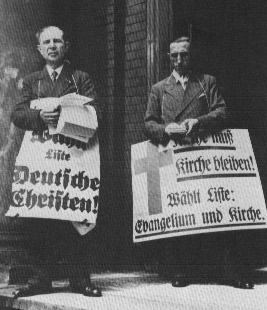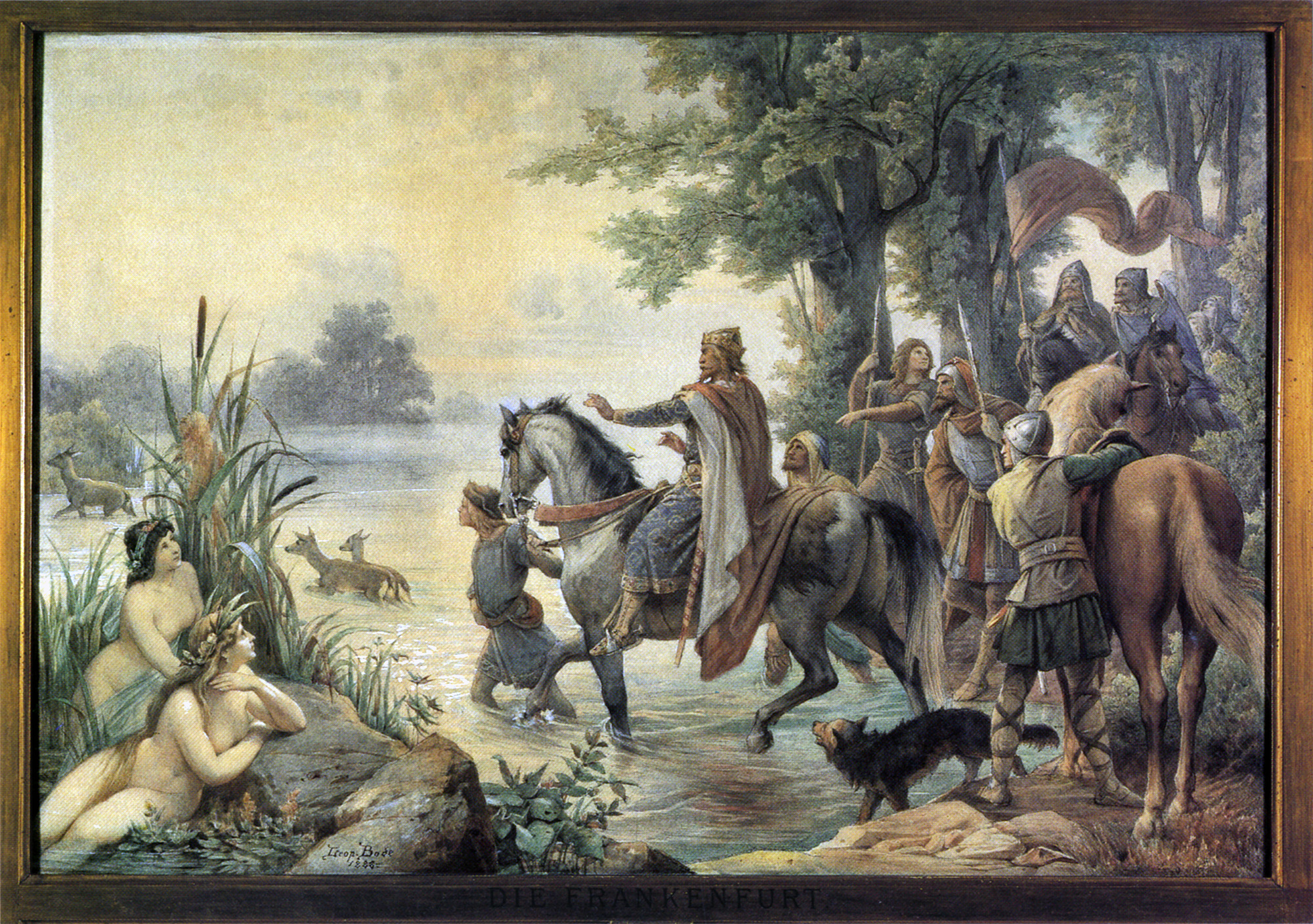|
Dreikönigskirche, Frankfurt
The Dreikönigskirche (English: Church of the Three Kings) is a Lutheran Protestant church and parish in Frankfurt, the city's largest Protestant parish. It is located on the south bank of the Main in Sachsenhausen, opposite the Frankfurt Cathedral. The present church building, replacing an older church, was erected from 1875 to 1880 on designs by Franz Josef Denzinger in Gothic revival style. It features stained glass windows by Charles Crodel, installed in 1956, and an organ by Karl Schuke from Berlin completed in 1961. After World War II, the church developed into a centre of church music, with Kurt Thomas as the church musician and Helmut Walcha as the organist. It offers cantata services and concerts. The church is a listed monument, basically preserved as originally designed. History At the location of the present church, in Sachsenhausen on the Main, across the river from the Frankfurt Cathedral, a hospital chapel was consecrated to the Three Kings (''Drei Könige'') in ... [...More Info...] [...Related Items...] OR: [Wikipedia] [Google] [Baidu] |
Frankfurt Am Main-Dreikoenigskirche Vom Mainkai-20110408
Frankfurt, officially Frankfurt am Main (; Hessian dialects, Hessian: , "Franks, Frank ford (crossing), ford on the Main (river), Main"), is the most populous city in the States of Germany, German state of Hesse. Its 791,000 inhabitants as of 2022 make it the List of cities in Germany by population, fifth-most populous city in Germany. Located on its namesake Main (river), Main River, it forms a continuous conurbation with the neighboring city of Offenbach am Main and Frankfurt Rhein-Main Regional Authority, its urban area has a population of over 2.3 million. The city is the heart of the larger Rhine-Main metropolitan region, which has a population of more than 5.6 million and is Germany's Metropolitan regions in Germany, second-largest metropolitan region after the Rhine-Ruhr region. Frankfurt's central business district, the Bankenviertel, lies about northwest of the geographic centre of the EU, geographic center of the EU at Gadheim, Lower Franconia. Like France and Franc ... [...More Info...] [...Related Items...] OR: [Wikipedia] [Google] [Baidu] |
Gothic Architecture
Gothic architecture (or pointed architecture) is an architectural style that was prevalent in Europe from the late 12th to the 16th century, during the High and Late Middle Ages, surviving into the 17th and 18th centuries in some areas. It evolved from Romanesque architecture and was succeeded by Renaissance architecture. It originated in the Île-de-France and Picardy regions of northern France. The style at the time was sometimes known as ''opus Francigenum'' (lit. French work); the term ''Gothic'' was first applied contemptuously during the later Renaissance, by those ambitious to revive the architecture of classical antiquity. The defining design element of Gothic architecture is the pointed or ogival arch. The use of the pointed arch in turn led to the development of the pointed rib vault and flying buttresses, combined with elaborate tracery and stained glass windows. At the Abbey of Saint-Denis, near Paris, the choir was reconstructed between 1140 and 1144, draw ... [...More Info...] [...Related Items...] OR: [Wikipedia] [Google] [Baidu] |
Frankfurter Kantorei
Frankfurter Kantorei (Frankfurt chorale) is a German mixed concert choir established in July 1945 by Kurt Thomas (composer), Kurt Thomas in Frankfurt. In 1969, Helmuth Rilling assumed leadership, and the choir began recording the complete List of Bach cantatas, Bach cantatas in 1972. From 1982 to 1997, Wolfgang Schäfer was artistic director of the Frankfurter Kantorei. Since then it has been led by Winfried Toll. The choir has performed concert tours abroad in Paris, Lyon, Venice, Turin, Vienna, Helsinki, St Petersburg, Istanbul, Los Angeles, Seattle and Toronto, among others, and first appeared in Israel in 1979. The group has made numerous CD recordings on the EMI Classics label. In 2000 they were a recipient of the Binding Kulturpreis, and in May 2000, they performed Brecht/Weill's ''Three Penny Opera'' at the Musiktriennale Köln of Cologne. The choir has a membership of about 70. In 1995, the ladies of the choir performed in a live recording of Zemlisky's opera ''Der Zwerg'' (T ... [...More Info...] [...Related Items...] OR: [Wikipedia] [Google] [Baidu] |
Orgel Dreikönigskirche (Frankfurt) ).
{{surname ...
Orgel is a surname, and may refer to: * Doris Orgel (born 1929), children's literature author * Leslie Orgel (1927–2007), British chemist * Stephen Orgel (21st century), Professor of English at Stanford University See also * Organ (music) (in nl, orgel, and in german: Orgel) * Orgle (a kind of Llama The llama (; ) (''Lama glama'') is a domesticated South American camelid, widely used as a List of meat animals, meat and pack animal by Inca empire, Andean cultures since the Pre-Columbian era. Llamas are social animals and live with othe ... [...More Info...] [...Related Items...] OR: [Wikipedia] [Google] [Baidu] |
Net Vault
A rib vault or ribbed vault is an architectural feature for covering a wide space, such as a church nave, composed of a framework of crossed or diagonal arched ribs. Variations were used in Roman architecture, Byzantine architecture, Islamic architecture, Romanesque architecture, and especially Gothic architecture. Thin stone panels fill the space between the ribs. This greatly reduced the weight and thus the outward thrust of the vault. The ribs transmit the load downward and outward to specific points, usually rows of columns or piers. This feature allowed architects of Gothic cathedrals to make higher and thinner walls and much larger windows. It is a type of arcuated, or arched, vault in which the severies, or panels in the bays of the vault's underside are separated from one another by ribs which conceal the groins, or the intersections of the panels. Rib vaults are, like groin vaults, formed from two or three intersecting barrel vaults; the ribs conceal the junction of ... [...More Info...] [...Related Items...] OR: [Wikipedia] [Google] [Baidu] |
Polygon
In geometry, a polygon () is a plane figure that is described by a finite number of straight line segments connected to form a closed ''polygonal chain'' (or ''polygonal circuit''). The bounded plane region, the bounding circuit, or the two together, may be called a polygon. The segments of a polygonal circuit are called its '' edges'' or ''sides''. The points where two edges meet are the polygon's '' vertices'' (singular: vertex) or ''corners''. The interior of a solid polygon is sometimes called its ''body''. An ''n''-gon is a polygon with ''n'' sides; for example, a triangle is a 3-gon. A simple polygon is one which does not intersect itself. Mathematicians are often concerned only with the bounding polygonal chains of simple polygons and they often define a polygon accordingly. A polygonal boundary may be allowed to cross over itself, creating star polygons and other self-intersecting polygons. A polygon is a 2-dimensional example of the more general polytope in any number ... [...More Info...] [...Related Items...] OR: [Wikipedia] [Google] [Baidu] |
Nave
The nave () is the central part of a church, stretching from the (normally western) main entrance or rear wall, to the transepts, or in a church without transepts, to the chancel. When a church contains side aisles, as in a basilica-type building, the strict definition of the term "nave" is restricted to the central aisle. In a broader, more colloquial sense, the nave includes all areas available for the lay worshippers, including the side-aisles and transepts.Cram, Ralph Adams Nave The Catholic Encyclopedia. Vol. 10. New York: Robert Appleton Company, 1911. Accessed 13 July 2018 Either way, the nave is distinct from the area reserved for the choir and clergy. Description The nave extends from the entry—which may have a separate vestibule (the narthex)—to the chancel and may be flanked by lower side-aisles separated from the nave by an arcade. If the aisles are high and of a width comparable to the central nave, the structure is sometimes said to have three naves. ... [...More Info...] [...Related Items...] OR: [Wikipedia] [Google] [Baidu] |
Protestant Church In Hesse And Nassau
The Protestant Church in Hesse and Nassau (german: Evangelische Kirche in Hessen und Nassau, EKHN) is a United Protestant church body in the German states of Hesse and Rhineland-Palatinate. There is no bishop and therefore no cathedral. One of its most prominent churches is Katharinenkirche in Frankfurt am Main. Dating back to the union in the Duchy of Nassau in August 1817, before the Prussian Union of September 1817, it is the first United and uniting church in the world. The EKHN is a full member of the Evangelical Church in Germany (EKD), and is based on the teachings brought forward by Martin Luther during the Reformation. The Church President is (since 2009). It is a united church, combining both Calvinist and Lutheran traditions. Member of the Reformed Alliance in Germany. The Protestant Church in Hesse and Nassau is one of 20 churches in the EKD, has 1,446,971 members in 1,184 parishes (December, 2020). The territory of the EKHN includes the territories of the former P ... [...More Info...] [...Related Items...] OR: [Wikipedia] [Google] [Baidu] |
Bekennende Kirche
The Confessing Church (german: link=no, Bekennende Kirche, ) was a movement within German Protestantism during Nazi Germany that arose in opposition to government-sponsored efforts to unify all Protestant churches into a single pro-Nazi German Evangelical Church. See drop-down essay on "Unification, World Wars, and Nazism" Demographics The following statistics (as of January 1933 unless otherwise stated) are an aid in understanding the context of the political and theological developments discussed in this article. *Number of Protestants in Germany: 45 million *Number of free church Protestants: 150,000 *Largest regional Protestant church: Evangelical Church of the Old Prussian Union (german: link=no, Evangelische Kirche der altpreußischen Union), with 18 million members, the church strongest in members in the country at the time. *Number of Protestant pastors: 18,000 **Number of these strongly adhering to the "German Christian" church faction as of 1935: 3000 **Number of the ... [...More Info...] [...Related Items...] OR: [Wikipedia] [Google] [Baidu] |
Frankfurt Dreikönigskirche 1859
Frankfurt, officially Frankfurt am Main (; Hessian: , " Frank ford on the Main"), is the most populous city in the German state of Hesse. Its 791,000 inhabitants as of 2022 make it the fifth-most populous city in Germany. Located on its namesake Main River, it forms a continuous conurbation with the neighboring city of Offenbach am Main and its urban area has a population of over 2.3 million. The city is the heart of the larger Rhine-Main metropolitan region, which has a population of more than 5.6 million and is Germany's second-largest metropolitan region after the Rhine-Ruhr region. Frankfurt's central business district, the Bankenviertel, lies about northwest of the geographic center of the EU at Gadheim, Lower Franconia. Like France and Franconia, the city is named after the Franks. Frankfurt is the largest city in the Rhine Franconian dialect area. Frankfurt was a city state, the Free City of Frankfurt, for nearly five centuries, and was one of the most im ... [...More Info...] [...Related Items...] OR: [Wikipedia] [Google] [Baidu] |
Baroque Architecture
Baroque architecture is a highly decorative and theatrical style which appeared in Italy in the early 17th century and gradually spread across Europe. It was originally introduced by the Catholic Church, particularly by the Jesuits, as a means to combat the Reformation and the Protestant church with a new architecture that inspired surprise and awe. It reached its peak in the High Baroque (1625–1675), when it was used in churches and palaces in Italy, Spain, Portugal, France, Bavaria and Austria. In the Late Baroque period (1675–1750), it reached as far as Russia and the Spanish and Portuguese colonies in Latin America. About 1730, an even more elaborately decorative variant called Rococo appeared and flourished in Central Europe. Baroque architects took the basic elements of Renaissance architecture, including domes and colonnades, and made them higher, grander, more decorated, and more dramatic. The interior effects were often achieved with the use of ''quadratura'', or ... [...More Info...] [...Related Items...] OR: [Wikipedia] [Google] [Baidu] |

.jpg)




